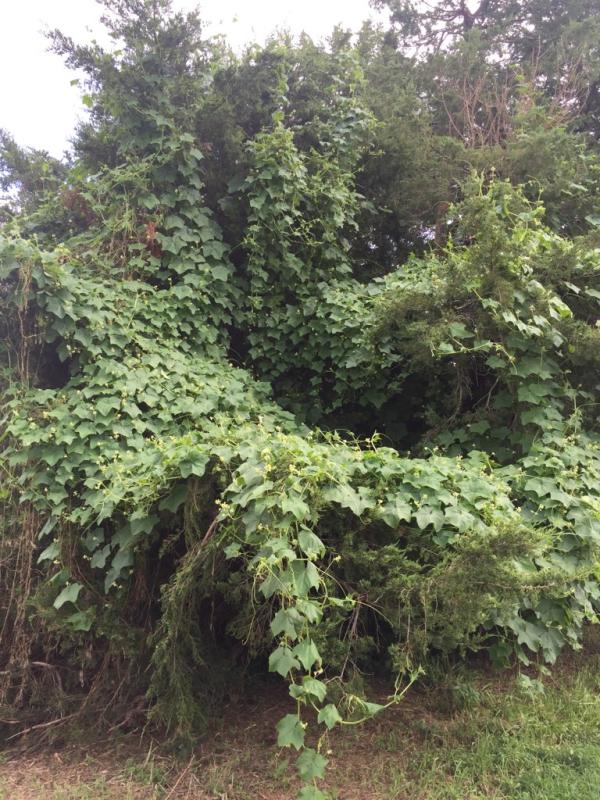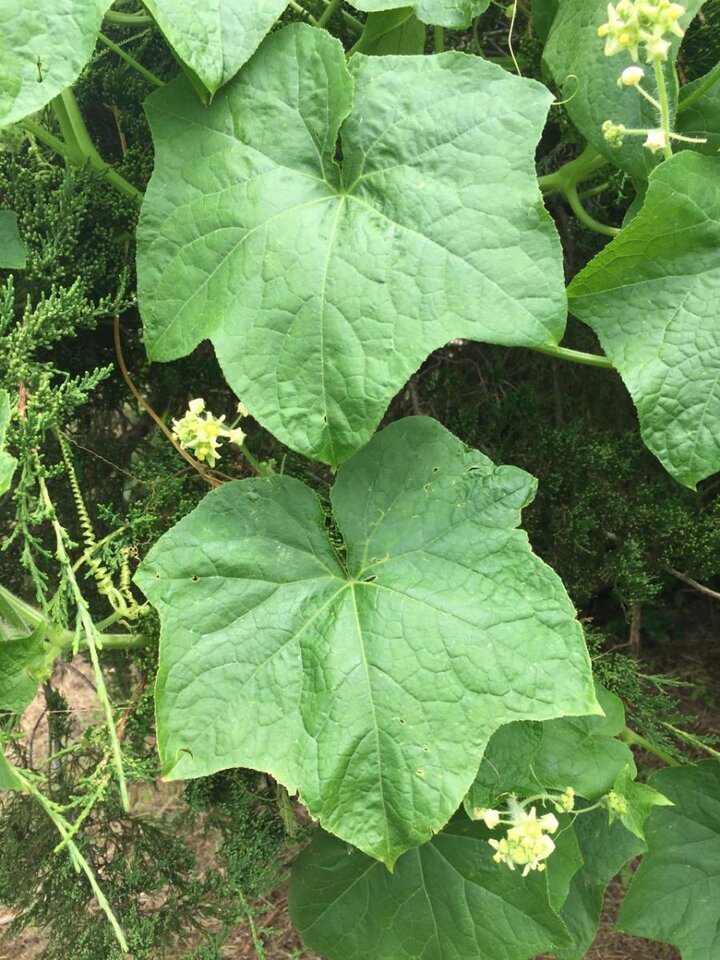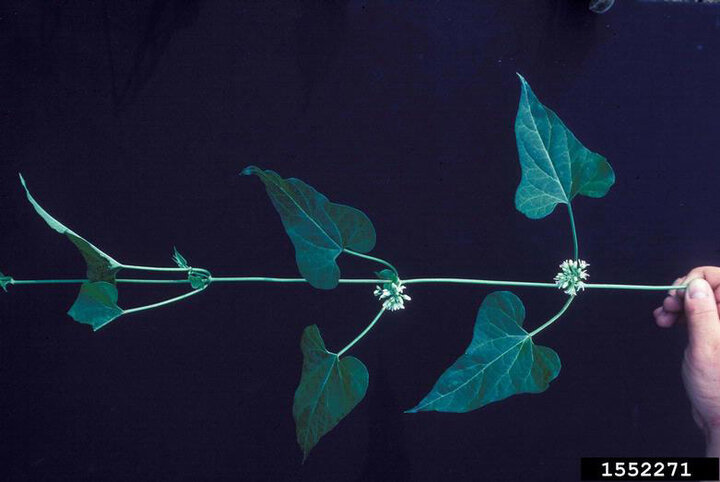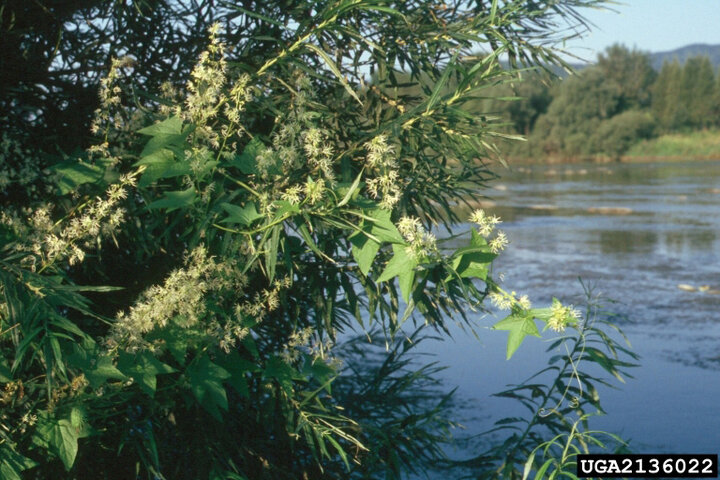Sarah Browning, Nebraska Extension Educator

Burcucumber vines grow very large and can cover large portions of a tree. Client image used with permission.
One of the most difficult weed situations to deal with on an acreage or large property is weedy vines growing in hedges or trees. Wild cucumber, burcucumber, and honeyvine milkweed are the most common culprits. These plants shade the foliage of the host plant, and interfere with their ability to photosynthesis. This is especially damaging to evergreen trees, which don’t tolerate shading well. Note: Field and hedge bindweed, and dodder can also be problematic, but will not be discussed here.

Weeds
Native to the United States, wild cucumber and burcucumber are annual vines, found in the same plant family as cucumber and muskmelon, although neither produces edible fruits. Both grow from seed each year, and can be found growing wild in prairie ravines, fence rows, creek and stream banks, and ditches wild cucumber (Echinocystis lobata), also known as balsamapple or mockcucumber, can grow 15 to 25 feet long. It has smooth stems and alternately placed, star-shaped leaves, each with 5 to 7 pointed lobes. Greenish white flowers grow on short stems arising from the leaf axils. The twining vines are aided in climbing by forked tendrils. It has oval fruits, up to two inches long, that are covered with sharp spines.
Burcucumber (Sicyos angulatus) vines can grow up to 10 feet tall. The alternate leaves are broad with three to five pointed lobes. The stems are slightly fuzzy and develop clasping forked tendrils, similar to grapevines. Both wild cucumber and burcucumber produce separate male and female flowers. In burcucumber, the male flowers are greenish-white to pale yellow growing on short stems, the female flowers are found in round clusters at the ends of short stems. Green to yellow fruits are covered with prickly bristles, and ½ to ¾ inches long.

Perennial Weed
Honeyvine milkweed (Cynanchum laeve or Ampelamus albidus) is a vining member of the milkweed family that can grow 6 feet or more long. It differs from wild cucumber and burcucumber, in that it is a perennial plant, growing back from the crown each year. Plants spread through underground rhizomes, and can regenerate if all the root system is not killed or removed.
Honeyvine milkweed has triangular, or elongated heart-shaped leaves located opposite each other on long, smooth stems. It may be confused with bindweeds or morning glories, but they have alternate leaves. Clusters of small white flowers are found in the leaf axils and develop into smooth, slender, elongated milkweed pods. When the pods mature and open, they release brown flattened seeds with silky white hairs.

Control
Wild cucumber and burcucumber seeds germinate throughout the summer especially after rain, which makes periodic scouting and removal crucial for control. Plants are growing strongly by July so scout areas with a history of problems, and pull or hoe weeds before they have a chance to grow up into hedge or windbreak plantings. In large areas, mowing can be effective. Repeated mechanical removal prevents plants from producing additional seed and reduces weed pressure over time.
Pre-emergent - Oryzalin(Monterey Weed Impede) is labeled for preemergent control in trees to kill weed seeds as they germinate.
Post Emergent - Glyphosate (RoundUp) can be sprayed or painted on small plants under trees to kill seedlings; it has practically no soil residual and if used carefully according to label directions will not damage desirable plants. DO NOT use Tordon or any product containing Dicamba, which have a period of soil residual activity and can move deeper in the soil to be absorbed by trees roots.
If weedy vines escape notice early in spring and grow up into trees, cut larger plant stems near the ground before plants begin to flower. DO NOT spray herbicides on vines in trees or hedges.
Resources:
Reference to commercial products is made with the understanding that no discrimination is intended and no endorsement by Nebraska Extension is implied. Mention does not imply approval or constitute endorsement by Nebraska Extension. Nor does it imply discrimination against other similar product.
Images:
- Close up of burcucumber leaves and flowers. Client image used with permission.
- Honeyvine milkweed leaves and flowers. Image from the Ohio State Weed Lab, The Ohio State University, Bugwood.org.
- Wild cucumber vine. Image from Barbara Tokarska-Guzik, University of Silesia, Bugwood.org.
Search Our Archive
Associated Video
Vine Weeds Control
They like to climb everything almost like they want to choke other plants.